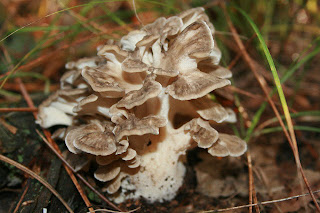Frightfully Tricky Forest Fungi
Written by Mary Ellen
 |
| These Shiitakes might look scary, but they sure taste great! |
Here is one of my darkest fears, my most grim dream: One day I’ll cook a sensational autumnal meal to celebrate the harvest season. It will be replete with forest fungi. All my closest friends and family will be there. You can guess where this is going …. maybe you’ve even had the same dream! Is it really possible that I could poison my loved ones with my favorite Cream of Shiitake Soup to witch :) a toadstool has found its way?
What, after all, is the likelihood that people who grow their own mushrooms will make a misidentification while picking and inadvertently consume it? For me, the likelihood is about as great as me carrying an AK-47 to my dinner party and spraying it about the room for dessert. I wouldn’t have the slightest idea how to use one let alone want to learn, so I believe fungal poisonings by my hand are highly unlikely.
Fungi can be a tricky lot. We know lots of folks who cook with mushrooms they harvest from their forest farm. Many new Shiitake mushroom growers pose the question “Would it be possible that the log I planted will also grow some poisonous ones?" The question is justified, after all- that’s one of the benefits of growing your own. If you’ve followed cultivation guidelines you can expect that what will grow there will be what you’ve planted. But like planting anything else outdoors, you can’t control everything that grows there. However, planting vigorous spawn in the proper substrate at the proper time should allow for solid establishment of whatever you’ve planted. Plus, once you positively identify your first cultivated mushrooms, you quickly become familiar with their every characteristic under every kind of weather condition, and you will be able to easily determine if there is a foreign fungus present. That said, ultimately the responsibility of correct identification is yours, and if you can’t identify it FOR SURE, it’s not edible!
If you are an outdoor mushroom grower, for peace of mind and as a good business practice, nothing beats educating yourself about the “Bad Guy” fungi out there. There are a few groups of mushrooms you should just steer clear of because gastronomic rewards of eating them are just not worth the risk of getting it wrong. While most fungi are not deadly poisonous, certainly names of such fungi like “The Sickener,” “Death Angel,” “Poison Pie,” and “Deadly Galerina” offer some clues and worry as to what will happen to you if you do eat it.
Amanitas are one such group; it includes the “Death Angels,” a group of three beautiful white amanita species that, if consumed, will likely kill you. Fortunately none of these look at all like any of the mushrooms you are likely trying to grow and are not found growing on wood, so of course you’ll steer clear of them if you are harvesting mushrooms such as Shiitake or Oyster that grow on logs.
 |
| Ironically these Death Angels have sprouted up right next to a skull! Photo courtesy of Joe Christian. |
Beware also of the collective group “LBM” or “Little Brown Mushrooms.” This group has some poisonous members, including one in particular “The Deadly Galerina,” which harbor the same toxin as do the Death Angels. This is a mushroom that provides the most fuel for my dark dream; it's brown, it grows on wood, it fruits in the fall; could it possibly be confused with Shiitake or Nameko? The deadly Galerina fruits on very old wood; I’ve only found it on fallen logs that are well on their way to barklessness and host many other wild fungi as well. This kind of log would be well past it’s usefulness as a shiitake log and I’ve never yet even found it on such a log. However, for a good look check this site or search Youtube with the words “deadly galerina” and you’ll get a good idea of what they look like!
 |
| This Deadly Galerina is scary every day of the year, not just on Halloween. |
The last group to be wary of consists of members of Cortinarius. which could be potentially confused with Blewit. Some species of this group are purplish like the Blewit, but turn them over and you will see a cobwebby veil underneath the cap, or “Cortina”. The gills turn rust brown and the stalk often has bits of this Cortina on it. Once again, familiarity of the Blewit will give you the best insurance as to what is NOT a blewit. For more info go to the mushroom forager or mushroom-collecting.
If you are a video person, avoid all tricks and treat yourself to Taylor Lockwoods DVD “The Good, the Bad and the Deadly.” It’s greatly informative, presented very clearly, and is not just a one-time watch DVD. You’ll want it in your library. It also covers each of the groups mentioned above. Happy Halloween!


















